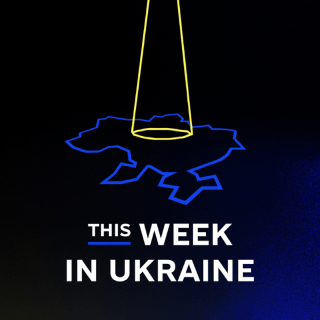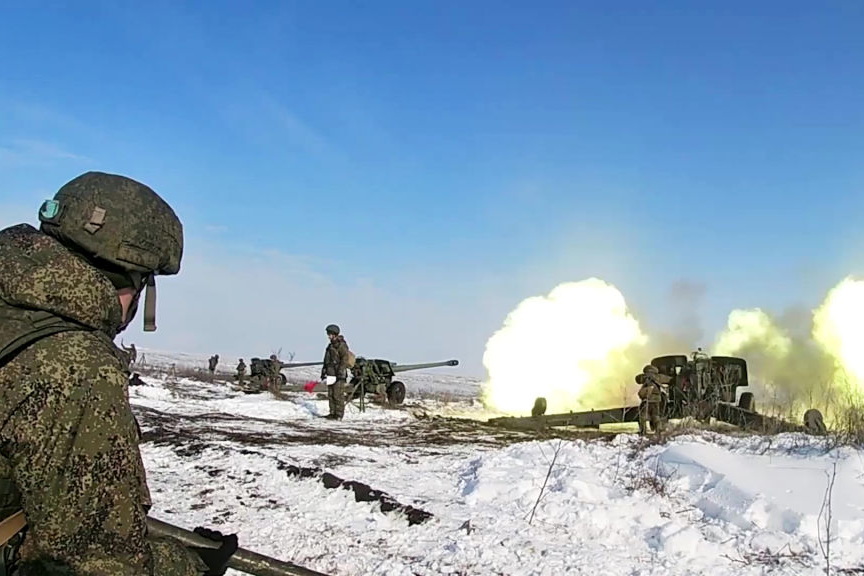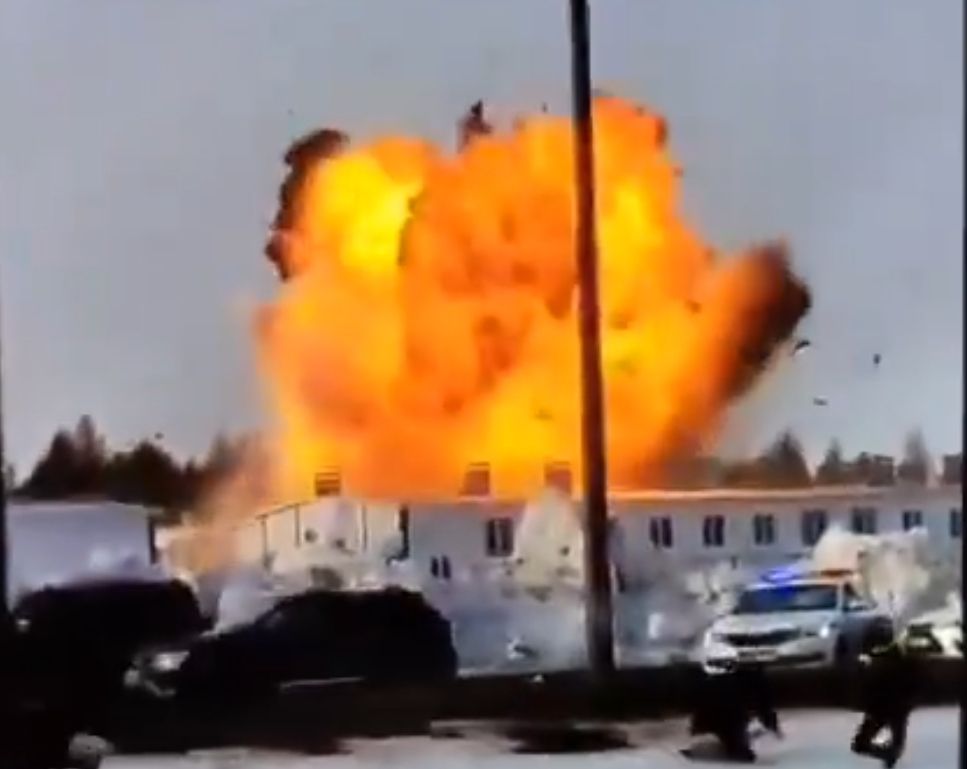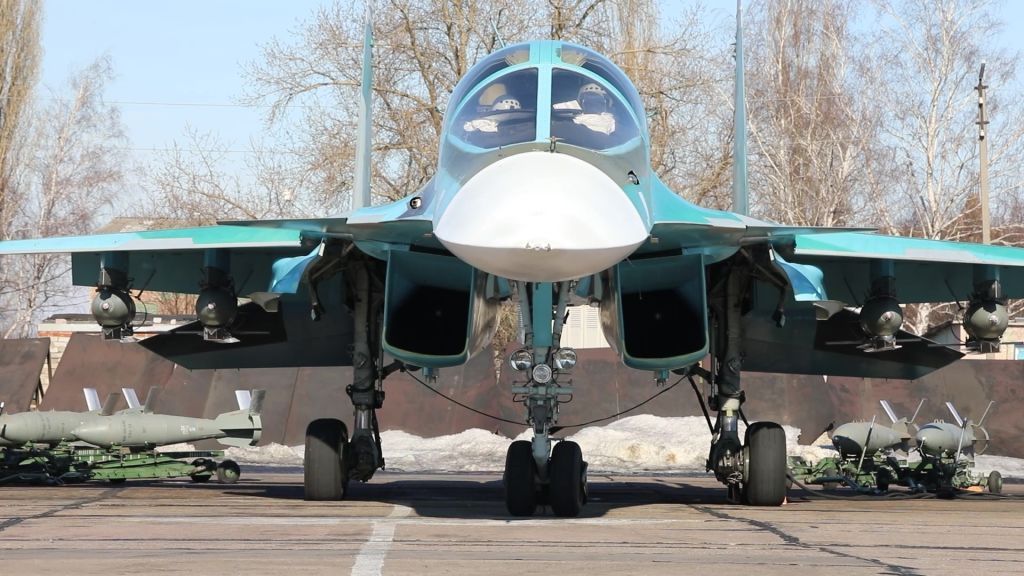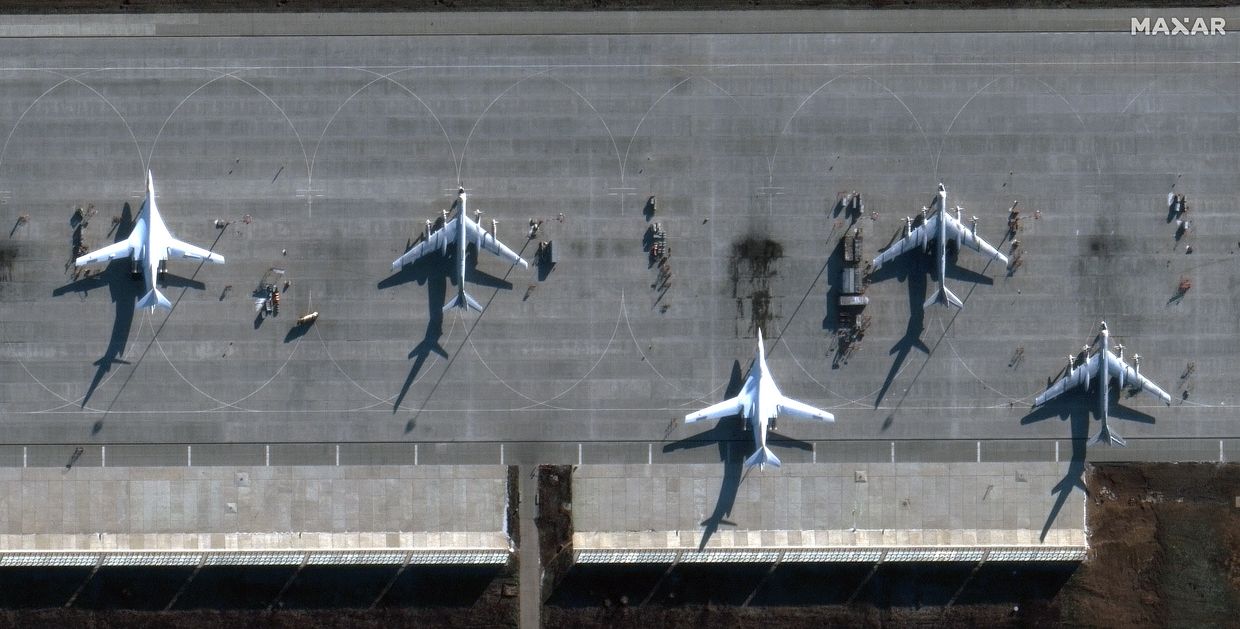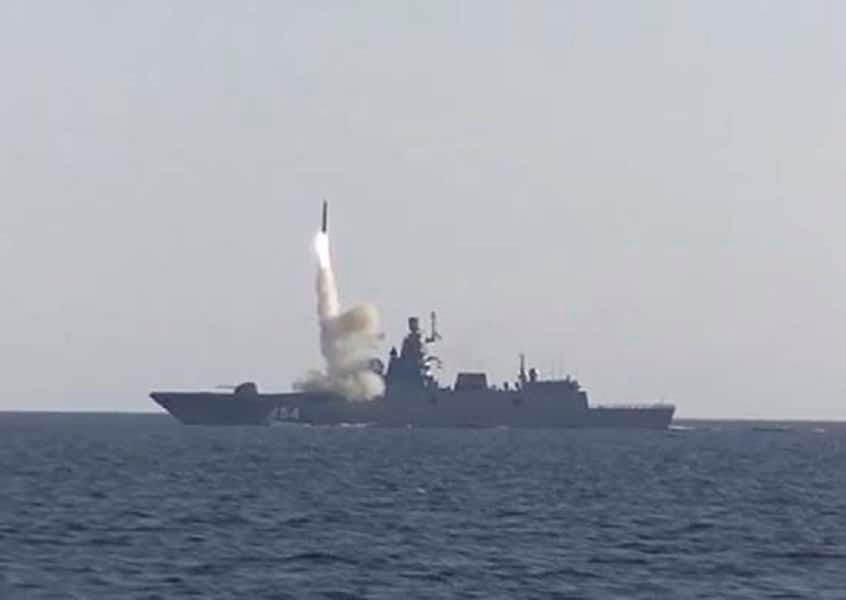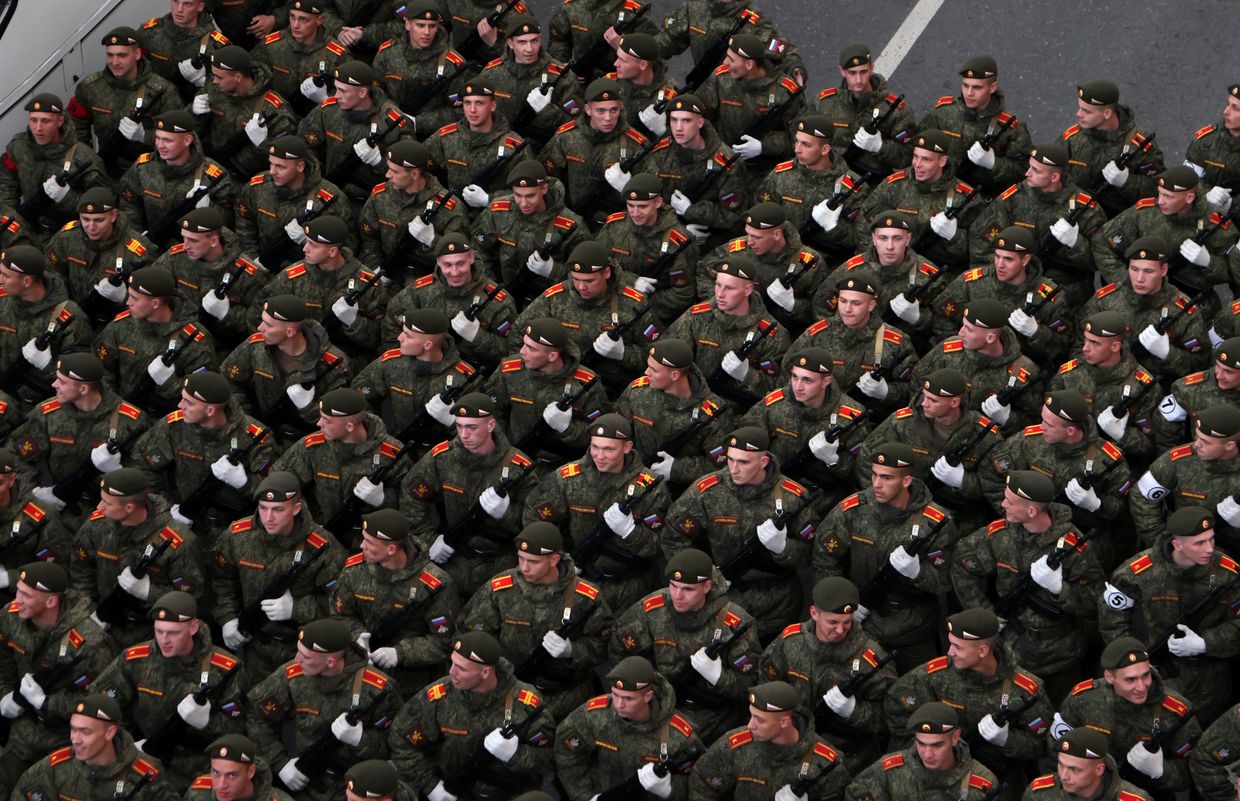As Russia continues to escalate its aggression against Ukraine, military experts disagree on the possible scenarios of a further Russian invasion if it does happen.
Russia has amassed around 135,000 troops around Ukraine and in its occupied areas in recent weeks and stepped up its aggressive rhetoric. The Kremlin has also issued demands that Ukraine should be forever banned from NATO and that the alliance should stop its eastward expansion.
The Kremlin may think that a large-scale invasion all the way to Kyiv or beyond could help it achieve its main objectives – bringing Ukraine into its sphere of influence and preventing its cooperation with NATO. However, the costs of such an operation may be devastating and even result in the collapse of Russia’s economy or regime.
A less risky option – a limited invasion in Donbas or in southern Ukraine – could help Russian President Vladimir Putin achieve some of his less ambitious goals. The downside for Russia is that it may lead to sanctions and an economic crisis while failing to strategically change the situation in favor of the Kremlin.
The Kyiv Independent looks at the most-discussed scenarios below.
Large-scale Russian invasion
Scenario: Russia invades the eastern part of Ukraine all the way to the Dnipro River and potentially attacks Kyiv and Odesa. The most extreme scenarios envisage Russia venturing into western Ukraine too.
“It seems plausible that Russian forces would seize Ukraine’s eastern regions, as well as the southern port city of Odesa, and encircle Kyiv,” Michael Kofman, a military expert at U.S. research non-profit CNA and the Kennan Institute, said in an op-ed.
Kofman and Rob Lee, a military expert at the U.S.-based Foreign Policy Research Institute, agree that long-term occupation, which would incur enormous costs, would unlikely be Russia’s goal.
“The most likely ground offensive option is that the Russian military would focus on destroying Ukrainian military units east of the Dnipro River, inflicting casualties, taking prisoners of war, destroying military equipment, and degrading defense capabilities,” Lee wrote. “This could include a planned withdrawal — a punitive raid — possibly after one or two weeks. It could also involve occupying terrain outside Kyiv and threatening the capital unless Russia’s demands are met.”
However, Kofman said that Russia may end up occupying parts of Ukraine anyway to achieve its objectives.
“Russia would not be the first country to invade another, misjudging the socio-political dynamics, and the costs of occupation,” he argued.
Who says it's likely and why: The main argument in favor of this scenario is that Putin is unlikely to achieve his more ambitious objectives in any of the other scenarios. These include preventing NATO’s eastward expansion, blocking Ukraine from joining or cooperating with NATO, increasing its influence in Ukraine, or installing a Russian-friendly regime in the country.
“It’s not clear how Moscow achieves its goals without conducting regime change, or a partitioning of the state, and committing to some form of occupation to retain leverage,” Kofman said.
Another argument is that Russia’s current economic situation allows it to withstand a crisis caused by a large-scale war.
“Russia’s elite may believe that they are in a good position to conduct a military operation and weather the storm of Western economic punishment,” Kofman said. “Having stabilized the Russian economy, established a war chest of reserves (over $620 billion) and tightened the screws on its opposition, the regime is more confident economically and politically.”
The U.S. government has so far failed to publicly threaten to impose the strongest sanctions in case of an invasion: to cut Russia off the SWIFT banking system, impose an oil and gas embargo or halt the Nord Stream 2 gas pipeline. Experts, including Russian political analyst Dmitry Oreshkin, estimate that the Russian economy is likely to survive unless these sanctions are imposed.
To secure the success of a large-scale invasion, Russia may also use its oil and gas supplies to Europe as a political tool as energy prices are soaring, according to Kofman.
He also said that Putin may mistakenly believe that much of the Ukrainian public has pro-Russian views, which would make a large-scale invasion more feasible.
Lee also argued that Russia will not achieve its main objectives unless it launches a major invasion.
“If Russia is determined to force constitutional changes in Ukraine or a modified version of the Minsk accords, it is unlikely to achieve this short of a ground invasion or heavy use of fires that could threaten the survival of the Ukrainian state,” he argued.
Ukrainian military expert Vyacheslav Tseluyko agreed with Kofman and Lee.
“Only one feasible variant is possible for Russia - a large-scale invasion capable of leading to the defeat or seizure of Ukraine within a short period,” Tseluyko told the Kyiv Independent. He argued that such an invasion may threaten Kyiv, Dnipro, and even Lviv.
Who says it's unlikely and why: Ukraine’s Center of Defense Strategies argued that a large-scale Russian invasion is unlikely.
“We do not observe the required formation of several hundred thousand troops, not only on the border with Ukraine, but also on Russian territory behind the front line,” the think-tank said in an op-ed.
Tseluyko countered, however, that Russia is capable of increasing the number of troops to make a large-scale invasion feasible in the near future.
The Center of Defense Strategies questioned Russia’s ability to hold occupied territories amid national resistance.
“Overall, a large-scale offensive operation with an attempt to hold large occupied territories is a gamble that has no chance of a positive outcome for Russia,” the center said. “When we add non-military components to this formula, such as international isolation and sanctions, then the result of an invasion will be politically suicidal for the Kremlin.”
The think-tank also said that “the seizure of key cities by the Russian armed forces is unlikely due to the high complexity of their maintenance, limited options for supply, and the possibility of encirclement of such cities by the Ukrainian armed forces, as well as active resistance, which could destroy or significantly damage any occupying forces.”
Tseluyko also said that a large-scale invasion “is pretty difficult given Ukraine’s size, large cities and the number and combat readiness of Ukrainian troops.”
Mason Clark, an expert at the U.S.-based Institute for the Study of War, assesses a large-scale Russian invasion as “highly unlikely".
“If Putin has decided that the only remaining way for him to achieve his objectives in Ukraine - permanently creating a relatively stable Ukrainian state under Moscow's sphere of influence - it would be a major break with his past and ongoing efforts against Ukraine and elsewhere,” Clark told the Kyiv Independent.
“A full invasion and occupation of Ukraine would impose substantial costs on Putin, including sanctions and Russian combat losses. An invasion would also force Putin to abandon his long-standing objective to reintegrate (the Kremlin-backed entities in Donbas) into the Ukrainian political system as Russian proxies, as well as to abandon the fiction that Russia is not a party in Ukraine's 'civil war.' Finally, the Kremlin would almost certainly face a protracted insurgency in occupied Ukrainian territory.”
Invasion in the south
Scenario: Russia launches naval and land-based warfare in the Ukrainian regions along the Black Sea coast.
The Center of Defense Strategies argued this scenario implies “significant aggravation of the security situation in the Azov and Black Sea region, involving the blocking of the Kerch Strait and Ukraine’s sea routes.”
The center said that this may include the occupation of Zmiinyi Island off the Black Sea coast in Odesa Oblast or a landing on the Black Sea coast to distract from or assist with other scenarios.
Kofman also mentioned that an attack on the port city of Odesa is possible.
Who says it's likely and why: Military analysts have speculated for years that Russia may try to create a “land bridge to Crimea” – to connect the illegally annexed peninsula with Russia by occupying the Black Sea coast – potentially including parts or all of Odesa, Kherson and Zaporizhia oblasts, as well as Mariupol in Donetsk Oblast.
This would supposedly resolve the problem of supplying Crimea with water, electricity, and other resources. Currently, Crimea is linked with Russia only through a bridge across the Kerch Strait.
Who says it's unlikely and why: The downside for Russia is that it is unlikely to achieve its more ambitious goals - such as preventing Ukrainian-NATO cooperation - while incurring significant costs in this scenario.
“It’s meaningless,” Tseluyko said. “Sanctions will be imposed, another front against the Ukrainian military will emerge, and for what? For water supplies for Crimea? But Crimeans have lived for eight years (without them) and will live for another 88 years. Putin doesn’t care about them.”
Invasion in Donbas
Scenario: Russia launches a limited invasion in Donbas. It may seize Ukrainian-controlled areas of Donetsk and Luhansk oblasts, recognize its proxy groups in the region as independent states, and deal a major blow to Ukraine’s military in eastern Ukraine.
Who says it's likely and why: The Center of Defense Strategies argued that “a large-scale armed escalation in eastern Ukraine with the official entrance of the Russian armed forces” is realistic.
One of the advantages would be the much smaller costs of warfare and occupation than a large-scale invasion of Ukraine.
“If Moscow has more limited objectives, such as deterring any future Ukrainian (Turkish-made TB2 drone) or artillery strikes in Donbas, it could achieve them with less force," Lee said. “This could include shooting down TB2 drones if they fly near Donbas or targeting their airfields with long-range munitions. Russia could also declare a no-fly zone or announce that the Russian military would respond to any further Ukrainian artillery strikes in Donbas with an overt response from the Russian military… A campaign of missile and artillery strikes could be limited to targeting specific Ukrainian military capabilities — for example, Ukrainian artillery units that fired on positions in Donbas.”
Clark said that the likelihood of a limited Russian attack in Donbas has increased in recent weeks.
“A partial Russian attack that retains the visible capability to go further increases pressure on the West and Ukraine to meet some of Putin’s demands,” he said.
“Holding back from attacks on Kyiv and major Ukrainian cities allows Putin to continue to demand concessions and protract the crisis. He can continue his efforts to maximize the tension and friction among Ukraine and its partners by using the threats of continuing air attacks, the economic devastation of Ukraine and Europe, or, finally, the invasion and occupation of Ukraine.”
Who says it's unlikely and why: The counter-argument against such a scenario is that the Kremlin is unlikely to bring Ukraine back into its orbit or prevent it from cooperating with NATO.
“A smaller campaign, perhaps seizing the rest of Donbas, would have high costs and risks,” Kofman said. “What does this gain Moscow in Ukraine, or in terms of revising its position in Europe? If anything, it worsens Russia’s current predicament. Russian leaders have acknowledged that their strategy of trying to leverage Donbas has failed to deliver and are unlikely to double down or repeat something that they concede won’t work.”
Tseluyko agreed that “any limited Russian invasion under the current circumstances is meaningless.”
“It will result in economic sanctions for Russia and the prospect of a prolonged war with a Ukraine backed by the West with its technological might,” he said.


